
Origin of the Christmas tree
Brief history and origin of the Christmas tree
The Christmas tree is set up every year by many people to increase the atmosphere around Christmas in the house. About 2.5 million Christmas trees are sold in the Netherlands every year: an enormous number. Many people combine the use of the Christmas tree with the distribution of presents. Where does the tradition of putting up the Christmas tree, hanging it with lights, come from? A brief history of the Christmas tree.
Germanic origin
The Christmas tree probably originated from Germanic traditions. But the Romans are also known to decorate their houses with green branches and lights. For the Romans and Teutons, green trees and branches symbolized fertility and divinity. They noticed that there was one tree species that always remained green: the pine tree. Other trees lost their leaves or turned brownish, but not the pine tree. The choice of decorations, such as stars and moons, shows that the tree was ascribed some divinity.
Spring
The green tree also announced the new spring, a time of flowering. That is why the Germans put down a green tree during the midwinter night, the shortest day of the year. Often in the middle of the village. This was then decorated with apples and other attributes, which indicated the start of a new season.
Late Middle Ages: trees taken over by the Christians
Sources show that Christmas trees were already in use during Christian winter festivals in the late Middle Ages, from the fifteenth century. This happened in Eastern Europe, the German areas and Scandinavia. Especially in the German countries, the use of Christmas trees was quite widespread. The trees that were used were already well decorated.
Christmas tree dates back to 1510
It is known that a large Christmas tree stood in a Roman Catholic cathedral in Strasbourg in 1539. An even older record of a decorated Christmas tree dates back to 1510. In Riga, Latvia, a local guild decorated a tree with artificial roses, danced around the tree and set it on fire. The rose is said to have symbolized the Blessed Virgin Mary.
Seventeenth century: Germans put trees in the house
In the sixteenth and seventeenth centuries, the wealthier Germans also began to plant a tree in their house. They hung apples in the tree, a reference to the so-called “Adam and Eve’s day” on December 24. Plays were performed to depict Bible stories, such as the Fall, for the illiterate masses.
The use of Christmas trees decorated with apples was soon adopted by the British nobility and during the nineteenth century the use of the Christmas trees spread to the rest of Europe.
The tree ends up in the United States
Franklin Pierce, 14th President of the United States
By 1800, German emigrants brought the tradition of the Christmas tree across the ocean and into the United States. It took only about 50 years for the Christmas tree to become commercial in the United States. The trees became bigger and bigger and more elaborately decorated.
In 1853
Franklin Pierce caused the first appearance of a Christmas tree in the White House in Washington. So the American presidents also changed their minds.
President Theodore Roosevelt, aka ‘Teddy’, attempted to ban the Christmas tree in 1901. It was the custom to remove the trees from the forests and according to Roosevelt this was disastrous for the tree stock. Roosevelt’s two sons sprang into action and called in conservationist Gifford Pinchot, who convinced Teddy Roosevelt that Christmas tree use would not harm American forests.
Tree Farm
Theodore’s namesake Franklin D. Roosevelt said otherwise. He started his own Christmas tree farm in 1930 on his estate in Hyde Park, New York. Christmas trees were planted here for commercial purposes.
Introduction to Dutch Households via Sunday Schools in the Nineteenth Century
During the Réveil – a Christian revival movement in the nineteenth century – many Sunday schools were established in the Netherlands. Within these Sunday schools the custom arose to put down a tree around Christmas. This is how the Christmas tree tradition also became known among the ‘ordinary Dutch’. Earlier, especially among liberal Protestants in our country, it was customary to put up a Christmas tree in the house.
Resistance from the Roman Catholic Church
A father cuts a Christmas tree with his son – Franz Krüger
In the nineteenth and twentieth centuries, in particular, the Vatican strongly opposed the setting up of Christmas trees. After all, these trees had pagan origins and had little to do with Christian Christmas. Especially in the nineteenth century, the Roman Catholic Church regularly warned against the pagan customs around Christmas. No earlier than 1982 were there Christmas trees in the Vatican in Rome for the first time.
Introducing the Artificial Christmas Tree
The artificial Christmas tree was also introduced in the late nineteenth century. Several chain stores started selling artificial Christmas trees in 1883. The first artificial Christmas trees consisted of twenty-five loose twigs adorned with red-colored berries. The plastic tree only really became popular in the 1920s, probably partly because of the economic crisis of the 1930s: reuse of artificial Christmas trees was cheaper than buying a new tree every year.
For a short time, aluminum Christmas trees were also in circulation, but these were not commercially successful.
